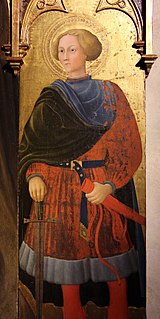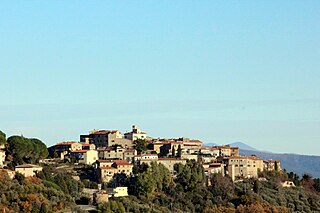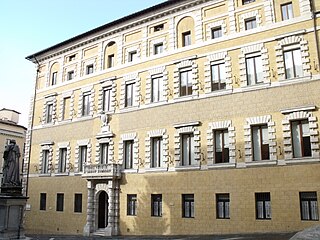The Palazzo San Galgano is a Renaissance style urban palace located on via Roma number 47, in Terzo Camollia of the city of Siena, region of Tuscany, Italy. The palace is around the corner from the church of San Raimondo.

The Palazzo San Galgano is a Renaissance style urban palace located on via Roma number 47, in Terzo Camollia of the city of Siena, region of Tuscany, Italy. The palace is around the corner from the church of San Raimondo.

The palace was commissioned in 1474 by the Giovanni di Niccolò, abbot of the Abbey of San Galgano; [1] the designs were by Giuliano da Maiano, who also designed the Sienese Palazzo Spannochi.
In the 16th-century, the palace underwent restructuring, when it housed the Congregation of the Abbandonate, and then of the Virgin del Soccorso. The courtyard portico dates from 1600, and the holy stairs and Chigi chapel date from 1710. The palace in 2015 houses the Department of Historical Sciences and Cultural Goods of the University of Siena. [2]
The palace, has six ground floor arches made from rusticated stone, now mostly walled. The second floor retains the mullioned windows. [3] Coordinates: 43°19′00″N11°20′19″E / 43.316695°N 11.338571°E

Saint Galgano was a Catholic saint from Tuscany born in Chiusdino, in the modern province of Siena, Italy. His mother's name was Dionigia, while his father's name only appeared in a document dated in the 16th century, when the last name Guidotti was attributed.

San Raimondo, also called San Raimondo al Refugio, is a Baroque style, Roman Catholic church located on the intersection of Via del Refugio and Via di Fiera Vecchia, in the Terzo of Camollia of the city of Siena, region of Tuscany, Italy. The church is dedicated to St Raymond of Pennafort.

The Basilica of San Domenico, also known as Basilica Cateriniana, is a basilica church in Siena, Tuscany, Italy, one of the most important in the city.

The Palazzo Chigi-Saracini is a Gothic urban palace on the Via di Città in the Terzo di Città in central Siena, Tuscany, Italy. In 2014 it housed the Accademia Musicale Chigiana.

Giuncarico is a village in Tuscany, central Italy, administratively a frazione of the comune of Gavorrano, province of Grosseto. At the time of the 2001 census its population amounted to 399.

Palazzo Salimbeni is a Gothic style urban palace located on the Piazza Salimbeni, just off Via Banchi di Sopra in the Terzo di Camollia of the city of Siena, region of Tuscany, Italy. The building, associated with an ancient mercantile family of Siena, currently houses the main offices of the Banca Monte dei Paschi di Siena, one of the oldest banks in the world.

The Abbey of Saint Galgano was a Cistercian Monastery founded in the valley of the river Merse between the towns of Chiusdino and Monticiano, in the province of Siena, region of Tuscany, Italy. Presently, the roofless walls of the Gothic style 13th-century Abbey church still stand. Nearby are the chapel or Eremo or Rotonda di Montesiepi (1185), the tomb of Saint Galgano and the purported site of his death in 1181, a sword said to have been driven into a stone by Galgano, and a chapel with frescoes by Ambrogio Lorenzetti.

Piazza d'Aracoeli is a square of Rome (Italy), placed at the base of the Capitoline Hill, in the Rione X Campitelli.

The Palazzo Tolomei is an imposing, Gothic style urban palace, located on Via Banchi di Sopra in the present contrada of Civetta, Terzo di Camollia of the city of Siena, region of Tuscany, Italy.

The Palazzo Bichi Ruspoli, or previously Palazzo or Castellare dei Rossi, is an urban palace, located on Via Banchi di Sopra in the present contrada of Civetta, Terzo di Camollia of the city of Siena, region of Tuscany, Italy.

The Palazzo Spannocchi is a Renaissance style urban palace located on the Piazza Salimbeni, just off Via Banchi di Sopra in the Terzo di Camollia of the city of Siena, region of Tuscany, Italy. The building was associated with an ancient mercantile family of Siena.

The Palazzo Piccolomini, also known as the Palazzo Todeschini Piccolomini is a Renaissance-style palace in the city of Siena, region of Tuscany, Italy. It is located on the Banchi di Sotto, at the corner with Via Rinaldini; uphill and west of the church of San Martino, the Loggia del Papa, and the Palazzo delle Papesse, which also built by a Piccolomini family member.

The Palazzo Palmieri, or Palazzo Nuti, is a Mannerist style urban palace, located on Via del Moro #48 in the present contrada of Civetta, Terzo di Camollia of the city of Siena, region of Tuscany, Italy.

The Palazzo Tantucci is a Renaissance style urban palace localized on Via dei Montanini, on the Piazza Salimbeni, in the Terzo di Camollia, in the city of Siena, region of Tuscany, Italy. To the palace's right is the Gothic facade of the Palazzo Salimbeni, and across the Piazza with Sallustio Bandini's statue is the Classic Renaissance facade of the Palazzo Spannocchi. All three palaces are owned now by the Monte dei Paschi di Siena, one of the oldest banks in Europe, which arose in the Salimbeni palace.

The Palazzo Arcivescovile or Archbishop's Palace of Siena is the official residence of the archbishop and the offices of the Archdiocese of Siena-Colle di Val d'Elsa-Montalcino. The neo-Gothic architecture building is located adjacent to the Cathedral of Siena.

Palazzo Sansedoni is a Gothic style urban palace and tower, whose concave facade is situated facing the Palazzo Pubblico across the Piazza del Campo in the political center of the city of Siena, region of Tuscany, Italy.

The Palazzo Celsi Pollini, once also called the Palazzo del Vescovo, is a Renaissance style urban palace in Siena, Italy. It is located on Pian dei Mantellini #39-41, at the corner with Via San Quirico. A 19th-century source refers to the house as Casa Campioni. The main facade faces the campanile of San Niccolò del Carmine.

The Palazzo Bandini-Piccolomini is a Renaissance style urban palace located on via Sallustio Bandini #32, corner Via San Vigilio in the city of Siena, region of Tuscany. It is across the street from the rear facade of the Castellare degli Ugurghieri. The palace was constructed circa 1460, and the design has been attributed to Cecco di Giorgio. The priest and proto-economist Sallustio Bandini was born in the house. The facade is mainly brick. The portal and window mouldings are made of grey pietra serena and has a Piccolomini shield with 5 crescent moons. The portal also has images of children astride dolphins. The second story windows have triangular pediments. The small interior courtyard has a well. The iron rings on the facade were formerly used to tie up horses. The property is owned by the University of Siena.

The Casino Mediceo di San Marco is a late-Renaissance or Mannerist style palace located on Via Cavour number 57 and via San Gallo in Florence, region of Tuscany, Italy.

The Palazzo Nonfinito is a Mannerist-style palace located on Via del Proconsolo #12, in central Florence, region of Tuscany, Italy. Begun in 1593 using designs by the architect Bernardo Buontalenti, only the first floor was completed, and additional construction was added later by different architects. The Palace is presently the home of the Anthropology and Ethnology section of the Museum of Natural History of Florence.
| | This article about a palace in Italy is a stub. You can help Wikipedia by expanding it. |